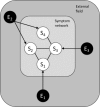A network theory of mental disorders
- PMID: 28127906
- PMCID: PMC5269502
- DOI: 10.1002/wps.20375
A network theory of mental disorders
Abstract
In recent years, the network approach to psychopathology has been advanced as an alternative way of conceptualizing mental disorders. In this approach, mental disorders arise from direct interactions between symptoms. Although the network approach has led to many novel methodologies and substantive applications, it has not yet been fully articulated as a scientific theory of mental disorders. The present paper aims to develop such a theory, by postulating a limited set of theoretical principles regarding the structure and dynamics of symptom networks. At the heart of the theory lies the notion that symptoms of psychopathology are causally connected through myriads of biological, psychological and societal mechanisms. If these causal relations are sufficiently strong, symptoms can generate a level of feedback that renders them self-sustaining. In this case, the network can get stuck in a disorder state. The network theory holds that this is a general feature of mental disorders, which can therefore be understood as alternative stable states of strongly connected symptom networks. This idea naturally leads to a comprehensive model of psychopathology, encompassing a common explanatory model for mental disorders, as well as novel definitions of associated concepts such as mental health, resilience, vulnerability and liability. In addition, the network theory has direct implications for how to understand diagnosis and treatment, and suggests a clear agenda for future research in psychiatry and associated disciplines.
Keywords: Psychopathology; diagnosis; mental disorders; mental health; network approach; resilience; symptom networks; treatment; vulnerability.
© 2017 World Psychiatric Association.
Figures




Comment in
-
Commentary: A network theory of mental disorders.Front Psychol. 2017 Aug 2;8:1305. doi: 10.3389/fpsyg.2017.01305. eCollection 2017. Front Psychol. 2017. PMID: 28824490 Free PMC article. No abstract available.
References
-
- Borsboom D, Cramer AOJ. Network analysis: an integrative approach to the structure of psychopathology. Annu Rev Clin Psychol 2013;9:91‐121. - PubMed
-
- Hyland ME. The origins of health and disease. Cambridge: Cambridge University Press, 2011.
-
- Kendler KS, Zachar P, Craver C. What kinds of things are psychiatric disorders? Psychol Med 2011;41:1143‐50. - PubMed
-
- Borsboom D. Psychometric perspectives on diagnostic systems. J Clin Psychol 2008;64:1089‐108. - PubMed
LinkOut - more resources
Full Text Sources
Other Literature Sources
Medical

